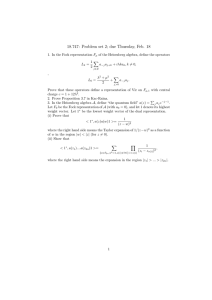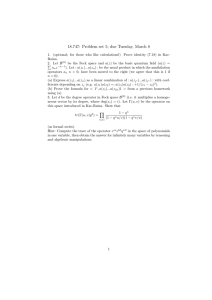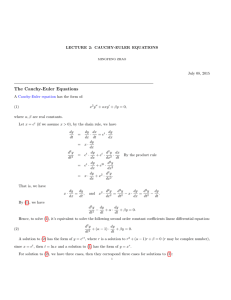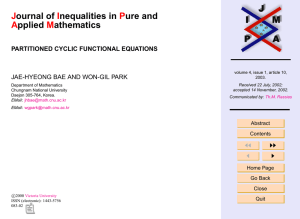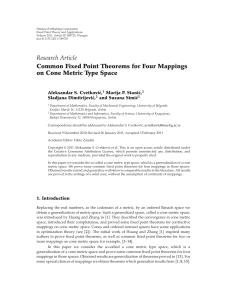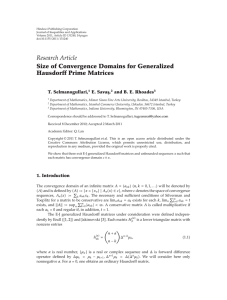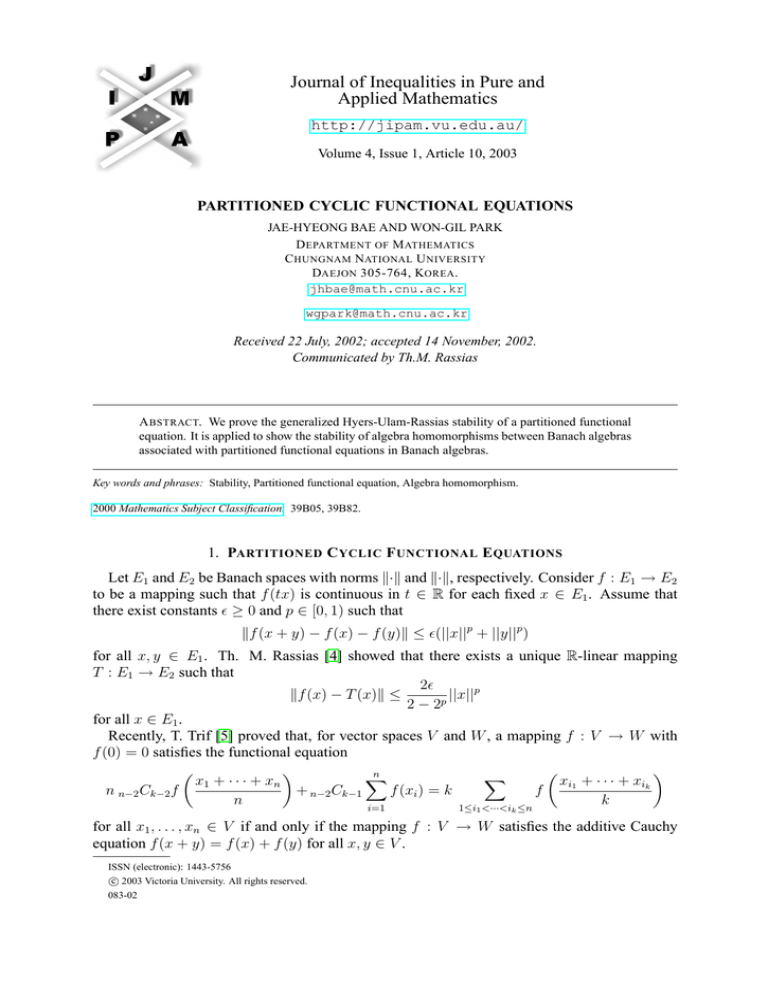
Journal of Inequalities in Pure and
Applied Mathematics
http://jipam.vu.edu.au/
Volume 4, Issue 1, Article 10, 2003
PARTITIONED CYCLIC FUNCTIONAL EQUATIONS
JAE-HYEONG BAE AND WON-GIL PARK
D EPARTMENT OF M ATHEMATICS
C HUNGNAM NATIONAL U NIVERSITY
DAEJON 305-764, KOREA .
jhbae@math.cnu.ac.kr
wgpark@math.cnu.ac.kr
Received 22 July, 2002; accepted 14 November, 2002.
Communicated by Th.M. Rassias
A BSTRACT. We prove the generalized Hyers-Ulam-Rassias stability of a partitioned functional
equation. It is applied to show the stability of algebra homomorphisms between Banach algebras
associated with partitioned functional equations in Banach algebras.
Key words and phrases: Stability, Partitioned functional equation, Algebra homomorphism.
2000 Mathematics Subject Classification. 39B05, 39B82.
1. PARTITIONED C YCLIC F UNCTIONAL E QUATIONS
Let E1 and E2 be Banach spaces with norms k·k and k·k, respectively. Consider f : E1 → E2
to be a mapping such that f (tx) is continuous in t ∈ R for each fixed x ∈ E1 . Assume that
there exist constants ≥ 0 and p ∈ [0, 1) such that
kf (x + y) − f (x) − f (y)k ≤ (||x||p + ||y||p )
for all x, y ∈ E1 . Th. M. Rassias [4] showed that there exists a unique R-linear mapping
T : E1 → E2 such that
2
kf (x) − T (x)k ≤
||x||p
p
2−2
for all x ∈ E1 .
Recently, T. Trif [5] proved that, for vector spaces V and W , a mapping f : V → W with
f (0) = 0 satisfies the functional equation
n
X
X
x1 + · · · + xn
xi1 + · · · + xik
n n−2 Ck−2 f
+ n−2 Ck−1
f (xi ) = k
f
n
k
i=1
1≤i <···<i ≤n
1
k
for all x1 , . . . , xn ∈ V if and only if the mapping f : V → W satisfies the additive Cauchy
equation f (x + y) = f (x) + f (y) for all x, y ∈ V .
ISSN (electronic): 1443-5756
c 2003 Victoria University. All rights reserved.
083-02
2
JAE -H YEONG BAE AND W ON -G IL PARK
Throughout this paper, let V and W be real normed vector spaces with norms k·k and k·k,
respectively, and let p, k and n be positive integers with k ≤ pn .
Lemma 1.1. A mapping f : V → W with f (0) = 0 satisfies the functional equation
n
(1.1) p f
x1 + · · · + xpn
pn
pn−1
X xpi−p+1 + · · · + xpi + p(k − 1)
f
p
i=1
pn
X
xi + · · · + xi+k−1
=k
f
k
i=1
for all x1 = xpn +1 , . . . , xk−1 = xpn +k−1 , xk , . . . , xpn ∈ V if and only if the mapping f : V →
W satisfies the additive Cauchy equation f (x + y) = f (x) + f (y) for all x, y ∈ V .
Proof. Assume that a mapping f : V → W satisfies (1.1). Put x1 = x, x2 = y and x3 = · · · =
xpn = 0 in (1.1), then
x
y x+y
x+y
x+y
n
(1.2) p f
+ p(k − 1)f
= k (k − 1)f
+f
+f
.
pn
p
k
k
k
Putting y = 0 in (1.2),
x
x
x
n
2
(1.3)
p f
+ p(k − 1)f
=k f
.
pn
p
k
Replacing x by kx and y by ky in (1.2),
kx + ky
kx + ky
n
+ p(k − 1)f
= k[(k − 1)f (x + y) + f (x) + f (y)].
(1.4)
p f
pn
p
Replacing x by kx + ky in (1.3),
kx + ky
kx + ky
n
(1.5)
p f
+ p(k − 1)f
= k 2 f (x + y).
pn
p
From (1.4) and (1.5),
0 = −kf (x + y) + k[f (x) + f (y)].
Hence f is additive.
The converse is obvious.
The main purpose of this paper is to prove the generalized Hyers-Ulam- Rassias stability of
the functional equation (1.1).
2. S TABILITY
OF
PARTITIONED C YCLIC F UNCTIONAL E QUATIONS
From now on, let W be a Banach space.
We are going to prove the generalized Hyers-Ulam-Rassias stability of the functional equation (1.1). From now on, n ≥ 2. For a given mapping f : V → W , we set
(2.1) Df (x1 , . . . , xpn )
pn−1 X
n
x
+
·
·
·
+
x
xpi−p+1 + · · · + xpi
1
p
n
2
+ p(p − 1)
f
:= p f
pn
p
i=1
pn
X
xi + · · · + xi+p2 −1
2
−p
f
p2
i=1
for all x1 = xpn +1 , . . . , xp2 −1 = xpn +p2 −1 , xp2 , . . . , xpn ∈ V .
J. Inequal. Pure and Appl. Math., 4(1) Art. 10, 2003
http://jipam.vu.edu.au/
PARTITIONED C YCLIC F UNCTIONAL E QUATIONS
3
Theorem 2.1. Let f : V → W be a mapping with f (0) = 0 for which there exists a function
n
ϕ : V p → [0, ∞) such that
(2.2)
ϕ(x)
e
:=
∞
X
x
x
x
x
<∞
,
0,
.
.
.
,
0
,
0,
.
.
.
,
0
pj ϕ
,
·
·
·
,
,
.
.
.
,
,
.
.
.
,
pj
j | {z }
j
j | {z }
p
p
p
j=0
| {z } p2 −p times
| {z } p2 −p times
p times
p times
and
(2.3)
kDf (x1 , . . . , xpn )k ≤ ϕ(x1 , . . . , xpn )
for all x, x1 = xpn +1 , . . . , xp2 −1 = xpn +p2 −1 , xp2 , . . . , xpn ∈ V . Then there exists a unique
additive mapping T : V → W such that
(2.4)
kf (x) − T (x)k ≤
(p2
1
ϕ(x)
e
− 1)pn−1
for all x ∈ V . Furthermore, if f (tx) is continuous in t ∈ R for each fixed x ∈ V , then T is
linear.
Proof. Let
x1 = · · · = xp = x, xp+1 = · · · = xp2 = 0,
xp2 +1 = · · · = xp2 +p = x, xp2 +p+1 = · · · = x2p2 = 0,
······ ,
xpn −p2 +1 = · · · = xpn −p2 +p = x, xpn −p2 +p+1 = · · · = xpn = 0
in (2.3). Then we get
n
x
x n−1 2
2
n
(2.5) p f
+ p (p − 1)f (x) − p · p f
p
p ≤ ϕ(x, . . . , x, 0, . . . , 0, . . . , x, . . . , x, 0, . . . , 0)
for all x ∈ V . So one can obtain
1
f (x) − pf x ≤
ϕ (x, . . . , x, 0, . . . , 0, , x, . . . , x, 0, . . . , 0)
2
p
(p − 1)pn−1
for all x ∈ V . We prove by induction on j that
j
1
1
j+1
(2.6) p f
x −p f
x j
j+1
p
p
pj
x
x
x
x
≤ 2
ϕ j , . . . , j , 0, . . . , 0, . . . , j , . . . , j , 0, . . . , 0
(p − 1)pn−1
p
p
p
p
for all x ∈ V . So we get
1
j
(2.7) f (x) − p f pj x j−1
X
1
x
x
x
x
m
≤ 2
p ϕ m , . . . , m , 0, . . . , 0, . . . , m , . . . , m , 0, . . . , 0
(p − 1)pn−1 m=0
p
p
p
p
for all x ∈ V .
J. Inequal. Pure and Appl. Math., 4(1) Art. 10, 2003
http://jipam.vu.edu.au/
4
JAE -H YEONG BAE AND W ON -G IL PARK
Let x be an element in V . For positive integers l and m with l > m,
l
1
1
m
(2.8) p
f
x
−
p
f
x
pl
pm l−1
X
1
x
x
x
x
j
≤ 2
p ϕ j , . . . , j , 0, . . . , 0, . . . , j , . . . , j , 0, . . . , 0 ,
(p − 1)pn−1 j=m
p
p
p
p
n
o
which tends to zero as m → ∞ by (2.2). So pj f p1j x
is a Cauchy sequence for all x ∈ V .
n
o
Since W is complete, the sequence pj f p1j x
converges for all x ∈ V . We can define a
mapping T : V → W by
1
j
(2.9)
T (x) = lim p f
x
for all
x ∈ V.
j→∞
pj
By (2.3) and (2.9), we get
1
1
j
kDT (x, . . . , xpn )k = lim p Df
x1 , . . . , j xpn j
j→∞
p
p
1
1
≤ lim pj ϕ j x1 , . . . , j xpn
j→∞
p
p
=0
for all x1 , . . . , xpn ∈ V . Hence T (x1 , . . . , xpn ) = 0 for all x1 , . . . , xpn ∈ V . By Lemma A, T is
additive. Moreover, by passing to the limit in (2.7) as j → ∞, we get the inequality (2.4).
Now let L : V → W be another additive mapping satisfying
1
kf (x) − L(x)k ≤ 2
ϕ(x)
e
(p − 1)pn−1
for all x ∈ V .
1
1
j
kT (x) − L(x)k = p T
x
−
L
x
pj
pj 1
1
1
1
j
j
≤ p T
x −f
x + p f
x −L jx j
j
j
p
p
p
p
2
1
≤ 2
pj ϕ
e jx ,
n−1
(p − 1)p
p
which tends to zero as j → ∞ by (2.2). Thus T (x) = L(x) for all x ∈ V . This proves
the uniqueness of T . Assume that f (tx) is continuous in t ∈ R for each fixed x ∈ V . The
additive mapping T given above is the same as the additive mapping T given in [4]. By the
same reasoning as [4], the additive mapping T : V → W is linear.
Corollary 2.2. If a mapping f : V → W satisfies
(2.10)
kDf (x1 , . . . , x2n )k ≤ ε(kx1 kp + · · · + kx2n kp )
for some p > 1 and for all x1 , . . . , x2n ∈ V , then there exists a unique additive mapping
T : V → W such that
2p−1 ε
(2.11)
kT (x) − f (x)k ≤
kxkp
p−1
3(2
− 1)
for all x ∈ V . Moreover, if f (tx) is continuous in t ∈ R for each fixed x ∈ V , then the function
T is linear.
J. Inequal. Pure and Appl. Math., 4(1) Art. 10, 2003
http://jipam.vu.edu.au/
PARTITIONED C YCLIC F UNCTIONAL E QUATIONS
5
Proof. Since ϕ(x1 , . . . , x2n ) = ε(kx1 kp + · · · + kx2n kp ) satisfies the condition (2.2), Theorem
2.1 says that there exists a unique additive mapping T : V → W such that
1
ϕ(x)
e
3 · 2n−1
∞
x p x p
X
1
j
=
2
ε
+
·
·
·
+
j
j
3 · 2n−1 j=0
2
2
kT (x) − f (x)k ≤
=
2p−1 ε
kxkp
3(2p−1 − 1)
for all x ∈ V .
Theorem 2.3. Let f : V → W be a continuous mapping
with f (0) = 0 such that (2.2) and
(2.3) for all x1 , . . . , x2n ∈ V . If the sequence 2j f 21j x converges uniformly on V , then
there exists a unique continuous linear mapping T : V → W satisfying (2.4).
Proof. By Theorem 2.1, there exists a unique linear mapping T : V → W satisfying (2.2).
By the continuity of f , the uniform convergence and the definition of T , the linear mapping
T : V → W is continuous, as desired.
3. A PPROXIMATE A LGEBRA H OMOMORPHISMS IN BANACH A LGEBRAS
In this section, let A and B be Banach algebras with norms k·k and k·k, respectively.
D.G. Bourgin [3] proved the stability of ring homomorphisms between Banach algebras. In
[1], R. Badora generalized the Bourgin’s result.
We prove the generalized Hyers-Ulam-Rassias stability of algebra homomorphisms between
Banach algebras associated with the functional equation (1.1).
Theorem 3.1. Let A and B be real Banach algebras, and f : A → B a mapping with f (0) = 0
n
for which there exist functions ϕ : A2 → [0, ∞) and ψ : A × A → [0, ∞) such that (2.2),
(3.1)
(3.2)
kDf (x1 , . . . , x2n )k ≤ ϕ(x1 , . . . , x2n ),
e y) :=
ψ(x,
∞
X
j=0
j
2ψ
1
x, y
2j
<∞
and
(3.3)
kf (xy) − f (x)f (y)k ≤ ψ(x, y)
for all x, y, x1 , . . . , x2n ∈ A, where D is in (2.1). If f (tx) is continuous in t ∈ R for each fixed
x ∈ A, then there exists a unique algebra homomorphism T : A → B satisfying (2.4). Further,
if A and B are unital, then f itself is an algebra homomorphism.
Proof. By the same method as the proof of Theorem 2.1, one can show that there exists a unique
linear mapping T : A → B satisfying (2.4). The linear mapping T : A → B was given by
1
j
(3.4)
T (x) = lim 2 f
x
j→∞
2j
for all x ∈ A. Let
(3.5)
R(x, y) = f (x · y) − f (x)f (y)
J. Inequal. Pure and Appl. Math., 4(1) Art. 10, 2003
http://jipam.vu.edu.au/
6
JAE -H YEONG BAE AND W ON -G IL PARK
for all x, y ∈ A. By (3.2), we get
j
lim 2 R
(3.6)
j→∞
1
x, y
2j
=0
for all x, y ∈ A. So
(3.7)
1
T (xy) = lim 2 f
(xy)
j→∞
2j
1
j
= lim 2 f
x y
j→∞
2j
1
1
j
= lim 2 f
x f (y) + R
x, y
j→∞
2j
2j
= T (x)f (y)
j
for all x, y ∈ A. Thus
1
1
1
1
1
(3.8) T (x)f
y = T x jy
=T
x y =T
x f (y) = j T (x)f (y)
j
j
j
2
2
2
2
2
for all x, y ∈ A. Hence
j
T (x)2 f
(3.9)
1
y
2j
= T (x)f (y)
for all x, y ∈ A. Taking the limit in (3.9) as j → ∞, we obtain
T (x)T (y) = T (x)f (y)
(3.10)
for all x, y ∈ A. Therefore,
T (xy) = T (x)T (y)
(3.11)
for all x, y ∈ A. So T : A → B is an algebra homomorphism.
Now assume that A and B are unital. By (3.7),
(3.12)
T (y) = T (1y) = T (1)f (y) = f (y)
for all y ∈ A. So f : A → B is an algebra homomorphism, as desired.
Corollary 3.2. Let f : A → B be a mapping such that (3.2), (3.3) and
(3.13)
kDf (x1 , . . . , x2n )k ≤ ε(kx1 kp + · · · + kx2n kp )
for some p > 1 and for all x, y, x1 , . . . , x2n ∈ A. If f (tx) is continuous in t ∈ R for each fixed
x ∈ A, then there exists a unique algebra homomorphism T : A → B such that
(3.14)
kT (x) − f (x)k ≤
2p−1 ε
kxkp
p−1
3(2
− 1)
for all x ∈ A.
Proof. By Corollary 2.2, there exists a unique linear mapping T : A → B such that (3.14). By
Theorem 3.1, the linear mapping T is an algebra homomorphism.
J. Inequal. Pure and Appl. Math., 4(1) Art. 10, 2003
http://jipam.vu.edu.au/
PARTITIONED C YCLIC F UNCTIONAL E QUATIONS
7
R EFERENCES
[1] R. BADORA, On approximate ring homomorphisms, preprint.
[2] J.-H. BAE, K.-W. JUN AND W.-G. PARK, Partitioned functional equations in Banach modules and
approximate algebra homomorphisms, preprint.
[3] D.G. BOURGIN, Approximately isometric and multiplicative transformations on continuous function rings, Duke Math. J., 16 (1949), 385–397.
[4] Th.M. RASSIAS, On the stability of the linear mapping in Banach spaces, Proc. Amer. Math. Soc., 72
(1978), 297–300.
[5] T. TRIF, On the stability of a functional equation deriving from an inequality of T. Popoviciu for
convex functions, J. Math. Anal. Appl., 272 (2002), 604–616.
J. Inequal. Pure and Appl. Math., 4(1) Art. 10, 2003
http://jipam.vu.edu.au/

